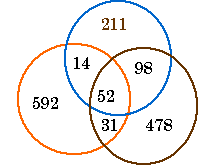

Venn diagram
Venn diagrams are named after the English logician John Venn who developed them in the early 1900s from an idea of Leonhard Euler.
Venn diagrams use circles to identify subsets of a set. The relationship of the circles shows how the sets are related. Sometimes the elements of the sets are also shown in a Venn diagram.
 |
In the Venn diagram to the left, the black dots represent people. All of the dots in the orange circle represent people who live in the country. The dots in the blue circle represent people who live in the city. These two sets do not overlap. The brown circle is drawn around the dots representing people who drive pickup trucks. It overlaps with the other two sets. From the diagram, then, one can deduce how many people live in the country and drive pickup trucks and how many people live in the city and drive pickup trucks. |
| In the Venn diagram to the right, all three sets have some elements in common. The sum of the numbers in the orange circle equals the number of people who live in the country; the sum of the numbers in the blue circle equals the number of people with blue eyes; and the sum of the numbers in the brown circle equals the number of people who drive pickup trucks. |  |
Copyright © 1999-2000 SciMathMN